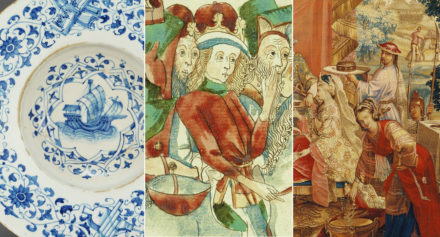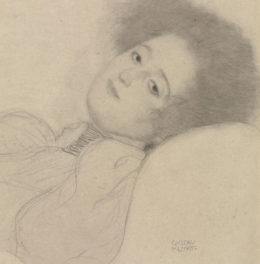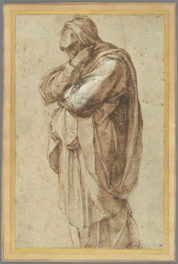
Lawrence Nees examines the text in a Getty Museum manuscript to identify it’s scribe.
Lawrence Nees is currently a visiting scholar in the Getty Museum’s Manuscripts Department, conducting research for a forthcoming book on Frankish manuscripts of the seventh to tenth centuries to be published as part of the series Manuscripts Illuminated in France, to be published by Harvey Miller and Brepols.
“If you ask most people what they think about ‘medieval,’ they’ll say ‘cold, dark, and brutal’,” says Nees. By investigating illuminations and textual sources such as leaves from a Carolingian manuscript in the Museum’s manuscript collection, he is working to debunk such myths about early medieval manuscript production. Long-held assumptions about the Middle Ages are often perpetuated by scholars and art historians and find their way not only into textbooks and popular culture, but into scholarship as well. “Don’t start with the conclusion and assemble evidence in support!,” he cautions.
One such misperception is the idea that scribes were “inspired, isolated monks.” By examining the Getty leaves, for example, Nees noted that they were penned by the same scribe, but in a different location, as a treatise in the holdings of the Vatican—one well known to historians, but not to art historians. Findings like this provide evidence that scribes might be skilled craftsmen-for-hire who worked and traveled throughout Europe.
Nees is also revising a myth associated with the Getty leaves. The book has been for many years associated with the daughter of Charlemagne, a claim that based on a later inscription found at the end of the book. This claim also relied on the commonly held assumption that the book’s purple pages necessarily indicate a royal patron or recipient. Several of the manuscript’s pages are a deep purple color, written in luxurious metallic inks. In the ancient roman world a precious purple dye was allegedly derived at great expense from the Murex sea snail and this costly color became associated with the emperors. In the Middle Ages purple had other associations, however, and was sourced from different organic materials. The pigment on this book is known to come from organic (plant-based) sources. Far from necessarily signifying royalty, the near contemporary poem written by the scribe and painter Godesscalc in a closely-related manuscript made for Charlemagne explicitly says that the purple color signifies the blood of Christ.
These findings complement Nees’s ongoing studies of Carolingian manuscripts and their relationship to the texts and forms of the ancient world. This relationship is also a more complex one than previously thought—and critical for scholarship on European thought, as almost everything we know of Greek and Roman literature, history, and science was preserved because it was copied in medieval manuscripts.
While at the Getty Nees gave a public lecture on Carolingian manuscript artists’ relationship to ancient sources, audio of which is below.
For a scholarly case study related to this topic, see Nees, “Aspects of Antiquarianism in the art of Bernward and its contemporary analogues,” in Angela Weyer and Gerhard Lutz, eds., 1000 Jahre St. Michael in Hildesheim. Kirche – Kunst – Stifter (Petersberg: Michael Imhof Verlag, 2012), pp. 153–170.
See all posts in this series »





Way to go, Larry!